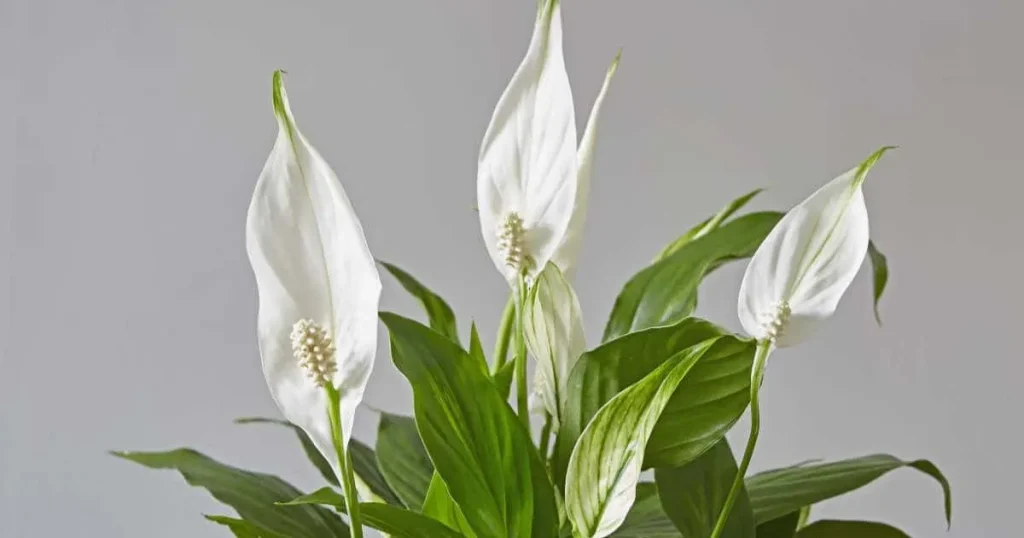Peace lilies, scientifically known as Spathiphyllum, are popular indoor plants cherished for their elegant, glossy green leaves and striking white flowers. They belong to the Araceae family and are native to tropical regions, particularly Central and South America. Peace lilies are well-known for their air-purifying qualities, enhancing both the beauty of indoor spaces and the air quality.
These plants are characterized by their deep green foliage and distinctive flower structure. The flowers consist of a white spathe surrounding a spadix containing the actual flowers. Peace lilies are easy to care for, making them perfect for new gardeners or those with minimal gardening knowledge.
Types of Peace Lilies
1. S.‘Mauna Loa Supreme’: Known for its large, showy flowers and robust growth.
2. Spathiphyllum ‘Power Petite’: A compact variety for smaller spaces or containers.
3. S.’Golden Delicious’: Features golden-yellow variegated leaves, adding a touch of color.
4. S.‘Sensation’: Recognized for its striking, elongated leaves and prolific blooms.
5. S. ‘Starlight’: Offers variegated foliage with creamy-white and green patterns.
6. S.’Mojo’: A petite variety with charming, petite flowers perfect for tabletop displays.
Peace Lily Care
Soil Requirements
Peace lilies thrive in well-draining, peat-based potting mixtures. The soil should be rich in organic matter to provide essential nutrients for healthy growth. Use well-draining soil and avoid heavy soils or those that retain too much water, as they can cause root rot and other problems.
Light Conditions
Peace lilies like bright, indirect light but can also handle low-light areas. Position them near windows with sheer curtains or in well-lit rooms without direct sunlight. Excessive sun can burn their leaves, so finding the right light balance is critical for healthy growth.
Watering
Watering is crucial to caring for Peace Lily plants, ensuring they thrive and stay healthy. Peace Lilies prefer slightly moist soil but can suffer from overwatering. It’s essential to strike a balance by watering them moderately and allowing the soil to dry somewhat between waterings.
A good rule of thumb is to water your Peace Lily when the top inch of soil feels dry. When watering, use room temperature water to avoid shocking the plant. Pour the water evenly around the plant’s base, ensuring it reaches the roots. Avoid waterlogging the soil, leading to root rot and other issues.
Humidity Levels
Peace Lilies do well in moderately humid to humid conditions, ideally between 40% and 60% humidity. You can boost humidity for your Peace Lily by placing a tray filled with water and pebbles nearby or using a humidifier in the room.
Maintaining proper humidity levels helps prevent issues like dry, brown leaf tips and promotes lush, healthy foliage. Regular misting can also help boost humidity around the plant, especially during dry seasons or in centrally heated or air-conditioned rooms.
Temperature Considerations for Peace Lily Plants
Temperature plays a significant role in the growth and well-being of Peace Lilies. Peace Lilies prefer temperatures typically found in indoor rooms, between 65°F to 80°F (18°C to 27°C). They don’t like sudden temperature changes, so keep them away from drafty windows or vents that blow hot or cold air.
During colder months, protect your Peace Lily from cold drafts and maintain a consistent temperature to avoid stress on the plant. Similarly, keep them away from direct sunlight in hot climates to prevent heat stress.
Temperature directly impacts the growth rate and overall health of Peace Lilies. Warmer temperatures promote faster growth and blooming, while cooler temperatures can slow growth and reduce flowering.
Extreme temperatures can cause leaf damage, such as brown spots or wilting. Monitoring the temperature and providing a stable, comfortable environment can encourage robust growth and vibrant blooms in your Peace Lily.
Fertilizing Peace Lilies
Fertilizing your Peace Lily is crucial for maintaining its vibrant green foliage and promoting beautiful blooms. Peace Lilies benefit from balanced, water-soluble fertilizers designed for houseplants. Choose a balanced fertilizer with equal parts nitrogen, phosphorus, and potassium (N-P-K ratio of 20-20-20 or similar).
Dilute the fertilizer to half its strength to prevent overfeeding. Apply it to the soil every 4-6 weeks in spring and summer, which is the growing season.
During the active growing months, which coincide with warmer temperatures and increased sunlight, your Peace Lily will appreciate regular feeding. However, reduce or stop fertilizing during the dormant phase in fall and winter when growth slows. Always check the soil moisture before fertilizing to avoid nutrient buildup or root damage.
Drainage
Peace Lilies need good drainage for healthy growth to avoid waterlogging and root rot. Use pots with drainage holes and well-draining potting soil. When transplanting, opt for a slightly bigger pot to accommodate growing roots. Loosen the root ball gently during transplanting to promote vigorous root growth in the new soil.
Proper drainage allows excess water to escape, preventing waterlogged soil that can suffocate roots. It also helps nutrient absorption and reduces the risk of fungal diseases caused by overly moist conditions. Maintain a balance between watering and drainage to keep your Peace Lily thriving.
Transplanting Guidelines for Healthy Growth
Transplant your Peace Lily every 1-2 years or when it outgrows its current pot. Choose a pot that is 1-2 inches larger in diameter and has adequate drainage. Carefully remove the plant from its old pot, gently loosen tangled roots, and place it in the new pot with fresh potting mix. Water thoroughly after transplanting and monitor the plant for any signs of stress.
Blooming and Bloom Care
Several factors play a crucial role in the blooming of Peace Lilies. Understanding these factors can help you create the optimal environment for vibrant blooms:
1. Light Exposure: Peace Lilies thrive in indirect sunlight. Too much direct sunlight can scorch their leaves, while insufficient light may lead to fewer blooms.
2. Temperature: Maintain a moderate temperature range, ideally between 65°F to 80°F (18°C to 27°C). Extremes in temperature can hinder blooming.
3. Watering: Adequate watering is essential. Overwatering or underwatering can stress the plant, affecting its ability to produce blooms.
4. Humidity Levels: Peace Lilies prefer high humidity. A pebble tray or humidifier can help create a humid environment, promoting blooming.
5. Nutrient Balance: Proper fertilization with a balanced fertilizer during the growing season supports healthy blooms. Avoid over-fertilizing, as it can lead to salt buildup and damage the plant.
Propagating Peace Lilies
Peace lilies, known for their elegant white flowers and lush green foliage, can be propagated through several methods.
Methods of Propagation
Division
This is the most common method for propagating peace lilies. It involves dividing the plant’s root ball into smaller sections, each with a portion of roots and foliage. Use a sharp, clean knife or gardening shears to carefully separate the plant into divisions, ensuring each division has healthy roots and leaves.
Rhizome Cuttings
Peace lilies produce rhizomes, underground stems that can be cut and replanted to grow new plants. Select a healthy rhizome with at least one bud or shoot. Cut the rhizome into sections, ensuring each has a bud or shoot. Plant the cuttings in moist, well-draining soil and keep them warm and humid for successful growth.
Leaf Cuttings
While less common, peace lilies can also be propagated from leaf cuttings. Choose a healthy leaf with a portion of the stem attached. Cut the leaf into sections, ensuring each section has a part of the stem. Plant the cuttings in peat moss and perlite, keeping the soil moist until roots develop.
Tips for Successful Propagation
Choose Healthy Plants: Select vigorous, healthy plants for propagation. Avoid using plants that show signs of disease or stress.
Use the Right Soil: Use a well-draining potting mix for peace lilies to ensure good root development and prevent waterlogging.
Provide Adequate Light: To encourage healthy growth, place newly propagated plants in a location with bright, indirect light.
Maintain Humidity: Peace lilies prefer humid environments. Use a humidity tray or mist the plants regularly to maintain humidity levels.
Monitor Watering: Keep the soil evenly moist but not waterlogged during the propagation process. Overwatering can lead to root rot.
Patience is Key: Propagation takes time, so be patient and allow the new plants to establish themselves before expecting significant growth.
Common Problems and Solutions
Pests Affecting Peace Lilies
While Peace Lilies are relatively resistant to pests, they can still encounter these common invaders:
Spider Mites: These tiny pests can cause webbing on leaves and stunted growth. Regularly inspect your plant and treat it with insecticidal soap if an infestation occurs.
Mealybugs: Identified by their white, cottony appearance, mealybugs can suck sap from leaves, leading to yellowing and wilting. Remove them manually and treat them with neem oil or insecticidal soap.
Scale Insects: Scale insects appear as small, round bumps on stems and leaves. Use a soft brush dipped in rubbing alcohol to remove them, repeating as necessary.
Dealing with Common Leaf Issues
Peace Lilies may experience various leaf problems, each requiring specific care:
Brown Tips: This often indicates either over-fertilization, underwatering, or exposure to fluoride in water. Adjust watering and feeding practices accordingly.
Curling Leaves: Curled and pale leaves often suggest the plant is getting excessive light. Scorched leaves, on the other hand, indicate too much direct sun. In both situations, it is best to move the plant to a spot with less light.
Yellow Leaves: Yellowing leaves may signal overwatering, poor drainage, or nutrient deficiencies. Adjust watering frequency, improve drainage, and fertilize as needed. If your plant’s leaves are turning yellow and it hasn’t been repotted, it might be a sign that it needs more room for its roots to grow. Consider repotting it into a new container that has proper drainage.
Wilting or Drooping Leaves: Overwatering, underwatering, or extreme temperature changes can cause wilting. Check soil moisture levels and adjust watering accordingly.
Peace Lily Toxicity
Peace lilies, while beautiful and popular as houseplants, contain substances that can be harmful if ingested or if their sap comes into contact with the skin or eyes. Understanding the plant’s toxicity is crucial for ensuring the safety of both humans and pets around these plants.
Peace lilies belong to the Araceae family, which includes other common houseplants like philodendrons and dieffenbachias. Their toxicity is primarily due to calcium oxalate crystals in their leaves, stems, and roots.
Safety Measures for Handling
Avoiding Ingestion: Place your peace lily plants in locations inaccessible to pets and young children who might chew on them. Ingestion can lead to symptoms like oral irritation, drooling, vomiting, and difficulty swallowing.
Protective Gear: When handling peace lilies, wearing gloves and protective clothing can prevent skin irritation from their sap.
Proper Cleanup: If any part of the plant breaks or leaks sap, clean it up immediately and wash your hands thoroughly afterward to avoid accidental exposure.
Growing and caring for peace lilies involves understanding their light, water, humidity, and nutrient needs. With proper care and attention to potential issues, you can enjoy thriving peace lilies that enhance your indoor environment with their beauty and air-purifying qualities.
- Top 12 Essential Gardening Tools for Beginners - June 19, 2024
- Top Gardening Tips for Beginners in 2024 - June 8, 2024
- How To Grow And Care For Peace Lily - April 28, 2024



